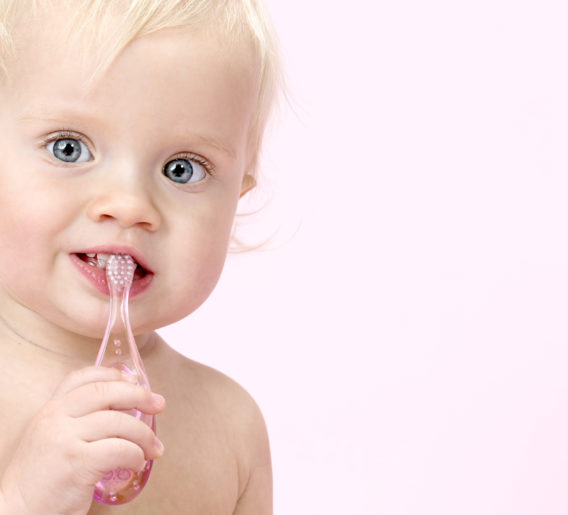To help soothe teething pain for your baby:
Give your baby something cold to chew on.Teething occurs when your baby’s milk teeth start pushing up through the gums. Some babies hardly seem to notice, whereas other babies will be really upset by the pain.
Symptoms of teething may start well before the teeth appear and include:
Some people think fever, rashes or diarrhoea are symptoms too, although scientific research hasn’t proved this link. If they occur, treat them as separate symptoms and get advice from your GP. Don’t ignore a high fever (ie over 38 degrees) on the assumption that it’s just teething. Always go to your GP for fever or diarrhoea.
Most babies start to teeth at around 6 months. However, all babies are different and there’s a really wide range of time during which the first teeth will start to emerge. Some babies are even born with teeth!
The usual range is between around 4 months and a year, but it can be even later than that as well.
The teeth will usually emerge in the following order:
1) Bottom front teeth (incisors), usually these come through at around 5-7 months;
2) Top front teeth (incisors), usually around a month later, around 6-8 months;
3) Each side of the top front teeth (top lateral incisors), around 9-11 months;
4) Each side of the bottom front teeth (bottom lateral incisors), around 10-12 months);
5) Back teeth (molars), around 12-16 months;
6) Canines, the pointy ones between the front set of 4 and the back molars , around 16-20 months;
7) Second molars, around 20-30 months
So by the time your baby is 2-3 years old, he will probably have most of his teeth!

You’ll probably need to experiment a little to find out what works best for your baby. Here are some things that are worth trying, and that have worked for many babies:
1) Something cold to chew on
Cool your finger under water and rub it gently over your baby’s gums.
You can buy a teething ring from a nursery store or chemist, and put it in the fridge to cool it down. Keep this sterilised. Liquid filled ones aren’t recommended because they can leak.
Or you can put a damp flannel/ face cloth in the fridge (don’t freeze) and let her chew on that. Make sure it’s a clean new one, that won’t fall apart quickly when chewed, you don’t want to risk bits of cloth coming off in your baby’s mouth as a choking hazard.
A dummy can help.
If your baby is over 6 months old and has started solids, you can give her lots of nice things to chew on. Avoid baby rusks biscuits since they’re usually crammed full of sugar. Try carrot sticks, cold bread, apple etc. Always watch your baby when she’s having finger food in case she chokes.
Cool water to drink can also really help.
2) Teething gels
If your baby is older than 4 months, you can try a baby teething gel (do not use adult oral gels). Some contain a mild anaesthetic to help with the pain. Some contain an antiseptic to help prevent an infection on the broken skin. You can ask your GP or pharmacist for advice. The effect usually lasts about 20 minutes but you need to time it carefully since you can’t use them more than 6 times a day.
Make sure your hands are really clean before you gently rub the gel on your baby’s gums.
Don’t give the gel just before a feed, since the numbing effect means they might not be able to latch on properly.
Gels which contain ‘choline salicylate’ should be avoided since there’s no scientific evidence they work and there is a small risk of the salicylate leading to a liver condition called ‘Reye’s syndrome’ in children under 16 years old.
3) Distraction/ Cuddles
It’s an old trick but it often works! If they’re crying a lot and unhappy, try a big change of scenery, take her in the buggy to the park and meet some friends to play with. Anything you can think of that’s fun and different that might take your baby’s mind of her sore mouth!
Putting half the toys away at any time is a great trick, so you always have a new one to bring out if you want to focus her attention on something.
4) Painkillers
If nothing else seems to work, and your baby is over 3 months old, you can try a small amount of baby paracetamol or ibuprofen. Don’t mix the two. Follow the instructions on the package precisely, do NOT give more than the recommended daily dose.
Try to wipe the teething drool off your baby’s face as often as you can. A clean muslin cloth is an idea for this. Do it really gently, don’t rub as that can make the rash worse. You can also try putting a barrier cream on, such as petroleum jelly or nappy cream.